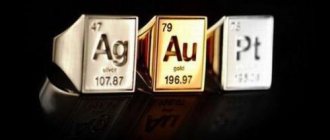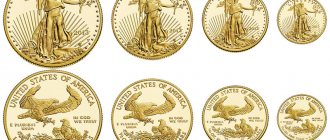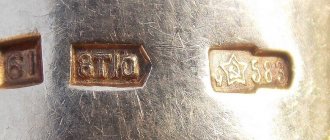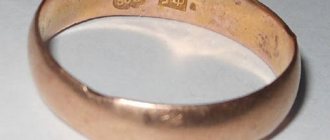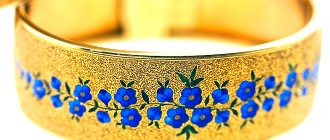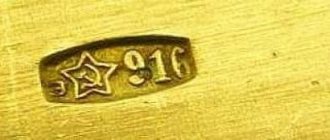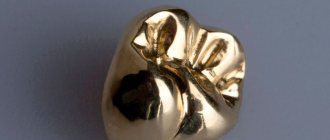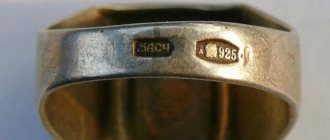Post updated: May 25, 2020
Gold is a noble metal that serves as a reflection of the power and wealth of the state or the wealth of a particular person. This metal is considered precious, because its quantity on the planet is limited, and its extraction requires special skills and a lot of time. For many centuries, this symbol of power has captivated seekers, leaders, and travelers. They are tirelessly searching for the gold of ancient peoples under the rubble of lost cities, and trying to identify ore deposits on mountain slopes and river valleys. What is pure gold, how to recognize it and how does it differ from other metals?
general information
Gold is a metal that is listed as number 79 on the periodic table of chemical elements. In Latin it is called Aurum, abbreviated as Au. Gold owes its name to its color, because in translation it means “yellow”. If we turn to mythological sources, then there is an obvious parallel with Aurora - the goddess of the morning dawn, who every day illuminates the sky with a morning golden strip of light. Gold is soft; the metal itself in its pure form is quite malleable and easily bends and changes shape.
It is not so easy to extract pure gold, because it can be hidden deep in the depths of rocks, or mixed with soil, silt, sand, and other minerals. Gold mining can be done industrially, in the form of mining a gold-bearing vein. In this case, the rock is sifted using special heavy equipment, leaving behind gold grains and throwing out unnecessary soil. Such equipment can also operate on a platform installed in a large body of water. A more painstaking, but quite relevant method of extraction is working in the mountains and on streams.
Typically, gold is washed out of the rocks and settles at the bottom of the stream. It is not always possible to find a large piece of metal; more often, prospectors are engaged in filtering silt and sand, during which gold grains settle at the bottom of special dishes. This method is possible due to the high density of the material. At the bottom you can also find nuggets - pieces of pure gold. However, the procedure is very labor intensive as the particles are often barely visible to the human eye.
Assortment of metal products “Ruler - S”
The hardest metal is chromium and titanium.
Chromium is an element of the secondary subgroup of the sixth group of the fourth period of the periodic system of chemical elements of D.I. Mendeleev, with atomic number 24. It is designated by the symbol Cr (Latin: Chromium). The simple substance chromium (CAS number: 7440-47-3) is a hard metal of a bluish-white color.
Chromium occurs in nature mainly in the form of chromium iron ore Fe(CrO2)2 (iron chromite). Ferrochrome is obtained from it by reduction in electric furnaces with coke (carbon): FeO Cr2O3 + 4C → Fe + 2Cr + 4CO↑
Chromium is a fairly common element; its content in the earth's crust is approximately 0.02% (22nd place). Ferrochrome is used for the production of alloy steels. To obtain pure chromium, the reaction is carried out as follows: 1) iron chromite is fused with sodium carbonate (soda ash) in air: 4Fe(CrO2)2 + 8Na2CO3 + 7O2 → 8Na2CrO4 + 2Fe2O3 + 8CO2↑ 2) sodium chromate is dissolved and separated from iron oxide; 3) convert the chromate to dichromate, acidifying the solution and crystallizing the dichromate; 4) pure chromium oxide is obtained by reduction of dichromate with coal: Na2Cr2O7 + 2C → Cr2O3 + Na2CO3 + CO↑ 5) metallic chromium is obtained using aluminothermy: Cr2O3+ 2Al → Al2O3 + 2Cr + 130 kcal 6) electrolytic chromium is obtained from a solution of chromic anhydride using electrolysis in water containing sulfuric acid. In this case, mainly 3 processes take place at the cathodes: reduction of hexavalent chromium to trivalent chromium with its transition into solution; discharge of hydrogen ions with the release of hydrogen gas; discharge of ions containing hexavalent chromium with precipitation of metallic chromium; Cr2O72− + 14Н+ + 12е− = 2Cr + 7H2O
Production of chromium The raw material for the industrial production of chromium is chromium iron ore. Its chemical processing leads to Cr2O3. Reduction of Cr2O3 with aluminum or silicon produces chromium metal of low purity: Cr2O3+Al=Al2O3+2Cr 2Cr2O3+3Si=3SiO2+4Cr Purer metal is obtained by electrolysis of concentrated solutions of chromium compounds.
Titanium - (Latin Titanium; denoted by the symbol Ti) - an element of the secondary subgroup of the fourth group, the fourth period of the periodic table of chemical elements of D.I. Mendeleev, with atomic number 22. The simple substance titanium (CAS number: 7440-32-6) - light metal of silvery-white color. Exists in two crystal modifications: α-Ti with a hexagonal close-packed lattice, β-Ti with cubic body-centered packing, α↔β transition temperature 883 °C
The softest metals are potassium, rubidium, cesium .
Potassium is an element of the main subgroup of the first group, the fourth period of the periodic system of chemical elements of Mendeleev D.I., with atomic number 19. Denoted by the symbol K (Latin Kalium). The simple substance potassium (CAS number: 7440-09-7) is a soft alkali metal with a silvery-white color. In nature, potassium is found only in combination with other elements, for example, in sea water, as well as in many minerals. It oxidizes very quickly in air and very easily enters into chemical reactions, especially with water, forming an alkali. In many respects, the chemical properties of potassium are very similar to sodium, but in terms of biological function and use by the cells of living organisms, they are still different.
Who needs gold?
Gold is being mined quite actively, especially now, due to growing demand and the capabilities of the latest technology. Its entire reserve is divided into pure gold and its alloys, of which, of course, there are more. Gold is used to back up national currencies, because everyone has heard about gold and foreign exchange reserves. Also, you can pay with gold, as well as invest your savings in it during an unstable economy.
More than a third of this metal on our planet is used in jewelry. In museums you can find jewelry and ritual items from ancient times, on the shelves of famous brands - rings, bracelets, earrings, pendants, and much more. In jewelry, gold is melted with the addition of other metals, but products can be coated with a thin layer of gold without impurities. Also, gold is actively used for industrial purposes and in dentistry.
Designations on precious metals
A gram of pure gold is expensive. The price of gold depends on its quality and percentage of pure metal content. By the way, in nature you will not find its maximum possible concentration; the mined ore is purified using refining, directing atoms of another substance into the metal structure to remove excess. As a result, you can get the most ideal metal, with almost 100% gold content.
How to understand how good an ingot or product is? Each of them, as a rule, has a marking that tells about the manufacturing company, the percentage of gold and its purity. There are several marking systems, but in any case a stamp is applied to the product - embossing containing information about the sample. This may be an abbreviation for the birthday person of a jewelry factory. In this case, the code consists of four letters, among which the first is the launch year code, the second is the code of the State Inspectorate of the Assay Factory, and the last two are the manufacturer’s code. Government control marks include the emblem of the country, which may be a coat of arms or a specially approved sign, and data on the composition of the gold. It is noteworthy that all precious metals have a certain stamp pattern.
Hallmarks on gold items sold in Russia.
Gold stamping can be applied in various ways; laser is the most accurate and accurate. Now not a single product can be put up for sale without labeling; all measurements are carried out in a government agency, which eliminates the risk of fraud.
[edit] Chemical properties
Dissolving gold in aqua regia
Gold is the most inert metal, standing in the series of stresses to the right of all other metals. Under normal conditions, it does not interact with most acids and does not form oxides, which is why it was classified as a noble metal, unlike ordinary metals, which are destroyed by the environment. Then the ability of aqua regia to dissolve gold was discovered, which refuted the idea that it is chemically inert.
The most stable oxidation state of gold in compounds is +3; in this oxidation state, it easily forms stable flat square complexes [AuX4]— with singly charged anions (F—, Cl—, CN—). Compounds with the oxidation state +1, which give linear complexes [AuX2]—, are also relatively stable. For a long time there was an opinion that +3 is the highest possible oxidation state of gold, however, using krypton difluoride, it was possible to obtain Au+5 compounds (AuF5 fluoride, salts of the [AuF6]- complex). Gold(V) compounds are stable only with fluorine; strong oxidizing agents.
By reacting atomic fluorine with gold pentafluoride, volatile fluorides of gold (VI) and (VII) were obtained: AuF6 and AuF7. They are very unstable, especially AuF6, which dismutates to form AuF5 and AuF7.[1]
The oxidation state +2 is unusual for gold; in substances in which it is formally equal to 2, half of the gold is usually oxidized to +1, and half to +3, for example, the correct ionic formula of gold (II) sulfates AuSO4 is not Au2+ (SO4)2-, and Au+Au3+(SO4)2-2, however, complexes have been found in which gold still has an oxidation state of +2.
There are gold compounds with an oxidation state of −1, which are called aurides. For example, CsAu (cesium auride).[2]
Systems for calculating impurities in gold
Pure gold, along with alloys, has such a quality assessment criterion as fineness. This is a numerical value that will tell you the percentage of impurities.
There are several measurement systems:
- Carats;
- Metric system;
- Spool valves.
Spool test is an attribute of Tsarist Russia; now it is found only in rare jewelry. The metric system is typical for the post-Soviet space, and in the West they prefer carats. Indicators in carats can range from 8 to 24, in the metric system - from 375 to 999. If we talk about compliance, we can give an example of equalizing both systems:
- 375 sample - 9 carats;
- 500 standard - 12 carats;
- 585 - 14 carats;
- 750 - 18 carats.
Of course, the numerical values are not arbitrary; they are legalized by GOST, which may be different in each country.
In Russia there are hallmark values: 375, 500, 583, 585, 750, 958, 999. Gold up to 375 hallmark is not used in Russia, but in Europe there are jewelry with a lower value.
Criteria for evaluation
The answer to the question of which metal is the softest will always be a subject of discussion unless the evaluation criteria are agreed upon and the very concept of softness is defined. Opinions about this material characteristic will vary among specialists in different industries. A metallurgist may understand softness as increased malleability, a tendency to accept deformations from abrasive materials, etc.
It is important for materials scientists to be able to objectively compare different characteristics of substances. Softness should also have generally accepted evaluation criteria. The softest metal in the world must have generally recognized indicators proving its “record” characteristics. There are several techniques whose purpose is to measure the softness of various materials.
Best cleaning result
Pure gold is 999 fine or 24 carats according to the European system. This kind of gold is also called red gold. It is used to produce bars that fill vaults and coins that are usually purchased by collectors. In the east, jewelry is even made from gold of this standard. In our everyday life, such gold is used for top coating and gilding. It can be used on jewelry, watches, furniture, figurines, and interior objects. Such a layer will not only protect from external influences, due to the increased inertness of the metal, but will also add nobility to antique-finished objects.
The question of how many carats are in a bar should not arise in pure gold. The purest sample is called “five nines” because its value looks like 99.999. It corresponds to 1000 in fineness and 24 in carats. Its color is natural yellow. The surface is shiny, the metal itself is very soft, it can be scratched with a fingernail. One of its advantages is malleability and ductility. The material is so malleable that it can be stretched to enormous lengths with microscopic thickness, or, on the contrary, flattened into the thinnest sheet without violating the integrity of the metal. Bank gold, which is quoted on the international market, corresponds to the figure of four nines (99.99).
How to determine the sample?
To determine the sample at home, you need to prepare:
- aqua regia;
- assay needles;
- nitric acid,
- chlorine gold.
How to check gold:
- Apply gold chloride to the surface.
- Wait a while.
Result:
- If after 2 seconds there is no change, the sample is either 585 or higher.
- Darkening of the metal indicates low quality of the alloy - the compound contains a large amount of copper, silver, and brass.
- If after 5 minutes a chestnut-colored spot appears at the site where the solution was applied, the sample is below 583.
Ingots
Of course, the metal comes in different forms, and the banking “format” of pure gold is the bullion. It can be produced by sheet metal, stamping or cast in one piece. The mass of the precious metal is measured in ounces or grams. There are bars that weigh 1 gram, these are used as gifts or payments on special occasions. In the bank you can buy bars of various sizes - 5, 10, 20, 50, 100, 250, 500 grams. The standard bar in the banking industry is 1000 grams.
An ounce is an international standard that indicates the volume and quality of an ingot. A troy ounce contains 31.1034768 grams. This measure originated from coins that were used in the Middle Ages. The figure for one ounce may vary among different historical sources. The Jewish unit of measurement is also known - the shekel. One shekel is 11.4 grams of pure metal. Asian countries have their own measurement measures.
Mohs hardness scale
This scale for determining the relative hardness of minerals and metals was proposed at the beginning of the 19th century by the German Friedrich Mohs. It is based on the scratching method, where a harder sample leaves a mark on a softer one, and is very convenient for finding out which metal is the softest. In relation to 10 reference minerals, which are assigned a conditional hardness index, the place on the scale and a digital index are determined for the test substance. The softest reference mineral is talc. It has a Mohs hardness of 1, and the hardest, diamond, is 10.
Gold on the international market
In order to find out how many carats the metal that is pure gold corresponds to, you can pay attention to the precious metals market. Bidding takes place on yellow metal of at least 999.9 purity. The precious metals index depends on the situation in the world and trading on the securities market. The price varies depending on the interest in buying metal. Most often, demand appears when the economy is destabilized, when large investors transfer their assets from foreign currency to more reliable metal ones.
Purchasing pure gold is a win-win investment; over the years of its mining, interest in it has never waned. If the acquisition of a block of shares may not be justified due to the bankruptcy of the company or a decrease in its value on the market, then there are fewer risks when purchasing gold. If you want to invest in the future, you should choose this asset. Over 10-15 years, the price will most likely allow you to remain a winner, and if you don’t make a profit, then keep your funds in full. You can buy jewelry for this, but a number of subtleties await you here. Selling jewelry after 2-3 years is not profitable for you. The price depends on tastes and fashion, since the design of the jewelry is very important, so there is a risk of not finding a buyer. In addition, the jewelry is made from an alloy, and prices for it are less predictable. By investing in pure gold in the form of coins or small bars, you are making a smarter move.
Gold is an indicator of wealth and a reward, decoration and decoration. The universal and rare precious metal has ruled the world for many centuries without losing ground. If your cherished dream is to purchase your own ingot, choose a high-quality sample that complies with GOST and international standards. You can always find one at a bank; choose the one that inspires you the most confidence.
Deposits and production
Leaders in production:
- China.
- Australia.
- Russia.
- USA.
- Canada.
- SOUTH AFRICA.
- Peru.
- Uzbekistan.
- Mexico.
- Ghana.
According to statistics, by 2014, 2809.5 tons of precious metal were mined in the world.
Statistics for Russia (Photo: Instagram / techade.ru)


